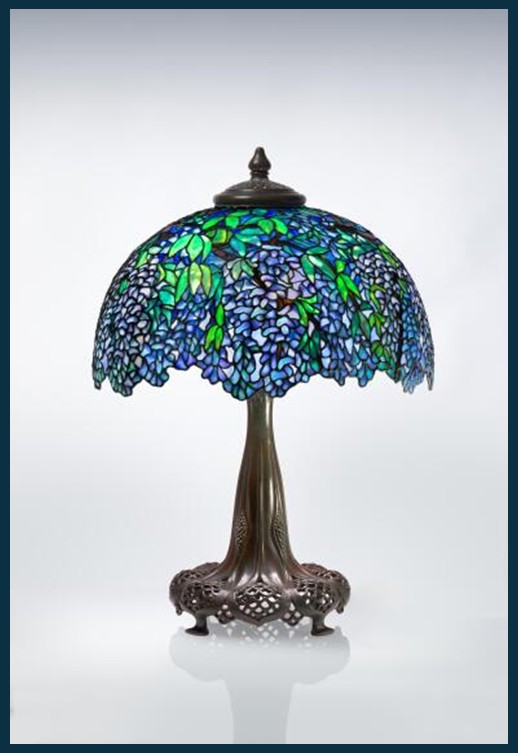
Maker: Tiffany Studios, 1902–32
‘Wisteria-Laburnum’ Table Lamp with a telescoping reticulated ‘Queen Anne’s Lace’ base, circa 1910, leaded glass, patinated bronze, Height: 73.8 cm, Private Collection https://www.sothebys.com/en/buy/auction/2024/louis-comfort-tiffany-artistry-in-glass-the-seymour-and-evelyn-holtzman-collection/a-unique-wisteria-laburnum-table-lamp
The Wisteria-Laburnum Tble Lmp by Tiffany Studios stands as a breathtaking testament to the union of art and nature. This exquisite piece, with its cascading floral motif and glowing hues, embodies Louis Comfort Tiffany’s vision of bringing the beauty of the natural world into everyday life. Recently featured at Sotheby’s, this one-of-a-kind lamp is not just a functional object but a masterpiece of design, craftsmanship, and innovation. Its intricate details and radiant colors continue to captivate collectors and admirers, offering a timeless reflection of Tiffany’s artistry and his enduring legacy in decorative arts. Is my Haiku attempt effective… Wisteria drapes / Purple whispers in soft light, / Tiffany marvels.
The Wisteria-Laburnum Table Lamp by Tiffany Studios holds significant importance for several reasons:
Artistic Mastery and Design Innovation: This lamp exemplifies Tiffany Studios’ unparalleled artistry and innovative design. The intricate leaded glass shade, composed of over 2,000 individually selected and cut pieces, mimics the cascading blossoms of wisteria and laburnum. Favrile glass depicting lush opalescent racemes, in shades of navy, blue, teal and purple-streaked pearlescent white, that descend to the irregular lower border. This meticulous arrangement of opalescent glass pieces creates a lifelike representation of nature, showcasing the studio’s commitment to transforming natural beauty into functional art.
Tiffany’s Fascination with Japanese Art: Louis Comfort Tiffany was deeply influenced by Japanese art, particularly its emphasis on harmony, simplicity, and the natural world. During the late 19th century, the Japonisme movement captivated Western artists, and Tiffany was no exception. He admired the Japanese approach to design, where art was seamlessly integrated into everyday life, and nature was celebrated through refined compositions and delicate forms. This admiration can be seen in his use of asymmetrical layouts, natural motifs, and intricate patterns, hallmarks of Japanese aesthetics. Tiffany’s stained glass creations, including lamps and windows, often reflected these principles, drawing inspiration from Japanese woodblock prints, textiles, and ceramics. His incorporation of these influences was not merely imitative but transformative, blending Japanese minimalism with the vibrant colors and textures of his signature glasswork.
Wisteria Vine and Its Use in Tiffany’s Art: Among the many natural motifs that inspired Tiffany, the wisteria vine held a special allure. Known for its cascading blooms and intricate patterns, the wisteria symbolized beauty, vitality, and the fleeting nature of life—concepts that resonated deeply with Tiffany’s artistic vision. He incorporated the vine into some of his most iconic designs, most notably the Wisteria Table Lamp. This lamp captures the essence of the flowering vine through cascading clusters of hand-cut, opalescent glass that mimic the soft, trailing blossoms of wisteria. The choice of colors—lavender, violet, and green—creates a vibrant yet serene effect, echoing the vine’s natural elegance. Tiffany’s fascination with wisteria exemplifies his ability to distill the beauty of nature into timeless works of art, transforming ordinary spaces into luminous sanctuaries of light and color.
Collaboration and Craftsmanship of the “Tiffany Girls”
The creation of this lamp highlights the exceptional skills of the “Tiffany Girls,” a group of female artisans led by designer Clara Driscoll. Their expertise in selecting, cutting, and assembling the glass pieces was crucial in bringing such complex designs to life. This collaboration underscores the significant yet often overlooked contributions of women in the decorative arts during the early 20th century. According to Sotheby’s experts… Clara Driscoll, the head of the firm’s Women’s Glass Cutters Department, is credited with the design, most probably with Louis Tiffany’s guidance and suggestions.
Rarity and Uniqueness
This particular Wisteria-Laburnum Table Lamp is considered unique, differing from standard models in its construction and design elements. For example, unlike the stiff form of the basic Wisteria shade, the undulating shape of this example creates a distinct sense of the blossoms being rustled by a gentle summer breeze. Such rarity enhances its value and desirability among collectors and art enthusiasts, reflecting the bespoke nature of Tiffany Studios’ creations and their willingness to experiment with forms and motifs
Cultural and Historical Significance
The lamp embodies the Art Nouveau movement’s emphasis on natural forms and intricate craftsmanship. Its design reflects the era’s search for elements of the natural world into interior spaces, serving as a historical artifact that offers insight into the aesthetic preferences and technological advancements of the early 1900s.
Enduring Legacy and Influence
The Wisteria-Laburnum Table Lamp continues to influence contemporary design and is celebrated in exhibitions and collections worldwide. Its enduring appeal lies in its harmonious blend of functionality and artistic expression, cementing Louis Comfort Tiffany’s legacy as a pioneer in decorative arts and inspiring future generations of designers to merge art with utility.
For a PowerPoint Presentation of Tiffany Lamps, please… Check HERE!